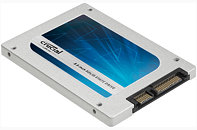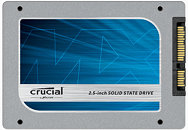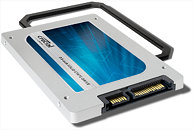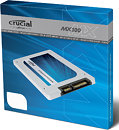Friday, May 30th 2014

Crucial MX100 SSD Specifications Appear Online
We're still a few days away from the official unveiling of MX100 solid state drive but thanks to a distributor jumping the gun we already have the full scoop on Crucial's latest creation. As previously revealed, the MX100 is set to be the first SSD equipped with Micron's 16 nm MLC NAND flash memory but not all models will have the 16 nm NAND - the 128 GB drive will pack 20 nm chips, while the 256 GB and 512 GB versions will have 16 nm flash.
All three MX100 drives come in a 7 mm-thick 2.5-inch chassis (a 9.5 mm adapter is included), and have a SATA 6.0 Gbps interface, a Marvell 88SS9189 controller, and are backed by a three-year warranty.Crucials' SSDs are capable of sequential read speeds of 550 MB/s while write speeds top 150 MB/s, 330 MB/s and 500 MB/s for the 128 GB, 256 GB and 512 GB models, respectively. The current pre-order prices are 70 Euro (128 GB), 95 Euro (256 GB) and 185 Euro (512 GB).
All three MX100 drives come in a 7 mm-thick 2.5-inch chassis (a 9.5 mm adapter is included), and have a SATA 6.0 Gbps interface, a Marvell 88SS9189 controller, and are backed by a three-year warranty.Crucials' SSDs are capable of sequential read speeds of 550 MB/s while write speeds top 150 MB/s, 330 MB/s and 500 MB/s for the 128 GB, 256 GB and 512 GB models, respectively. The current pre-order prices are 70 Euro (128 GB), 95 Euro (256 GB) and 185 Euro (512 GB).





22 Comments on Crucial MX100 SSD Specifications Appear Online
Since 128GB model is still using 20nm flash, im guess it went down..
I know my self - and 80% of my terabytes are movies that I never will watch again - it is nonsence for me to spend extra hundreds of $ to save them on SSD (just so I can load them 10 seconds faster - after all - that is a crappy movie that will waste a 1,5hours of my life, so I do not mind those few second for coppying from HDD to SSD, same with a crappy game .iso - it will waste hours of my life till I will get to conclusion: "uninstall that crap.... and never again!!!!" - so also there those few second of coppying over does not count ). for TeraBytes of crap to store HDD still rocks
Edit: The MX100 512 GB performs identically to the 512 GB M550 (except Max 4K Read IOPS, which are just 5,000 lower)... Good job Crucial... You just cannibalized your high end drives...
I guess Crucial decided that you need a minimum of 16 die for acceptable performance. If you were to use 128Gbit die in a 128GB SSD, that would mean only 8 die and therefore a slow SSD. It's the same as what Crucial did with the M550 to make sure that the low capacity drives still had acceptable performance.See the point above. They likely have to use 20nm 64Gbit die to maintain acceptable performance in the 128GB drive. In that case, 16 128Gbit chips at 16nm is likely not much more expensive than 16 64Gbit chips at 20nm thus reducing the cost difference between the 128GB and 256GB drives.
Waiting for reviews...
You need to understand, that crucial isn't using any nasty tricks like compression or turbowrite (or nCache in case of sandisk). Write speeds on m500 is actually comparable to 840EVO, once you take away turbowrite.
Sandforce drives are league on its own. Their write speeds usually sux aswell, they just look good on paper (due to compression).
And not that write speed matters much anyway. Bulk of workload on client ssds is read anyway.
M550 128 GB uses 16 64 Gb die and attains 300+ MB/s write speeds.
MX100 128 GB attains 150 MB/s write speeds.
Bingo?
And BTW, nCache is only used for storing the drive's firmware. It's not used for boosting write speeds.
And yes, nCache IS used for boosting write speeds. Educate yourself.
www.anandtech.com/show/6553/sandisk-ultra-plus-ssd-review-256gb
Small file writes are sent to the nCache to keep performance high, and idle time garbage collection likely dumps the nCache out to the much larger MLC array. The nCache was typically used as a way around having to use DRAM for data structure storage, but in the case of the Ultra Plus you get both: nCache + DRAM. I’m not sure there’s enough of an nCache in the Ultra Plus to make a big enough difference to justify the decision in this case.
What proof do you have that OCZ's performance mode makes a difference?? Don't quote Tomshardware because they haven't got a clue what they are talking.
nCache (as you could see from the anandtechs review) is intended for small writes, rather than big sequential writes, thats why its way smaller (~1GB). But sandisk is using pretty fast flash and 64Gbit dies, so write speeds don't suffer. It still makes it similar to turbowrite (pseudo SLC mode) just isn't used for all the writes.